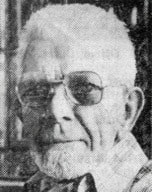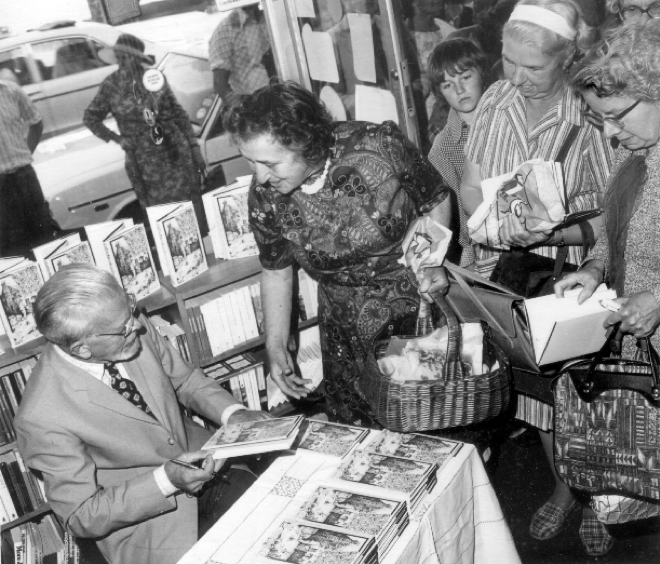dr. bill tandy
|
1904 - 1995
Bill Tandy was a much loved Forest doctor who in his writing demonstrated a respect, understanding and fondness for his adopted community. Growing up in Birmingham he moved to India soon after qualifying. Hearing about the Forest of Dean from a friend he moved here in 1940, working as a local GP until his retirement. His books draw on his experience as a doctor, here and in India. |
Early lIFE & cAREERWilliam Harry Tandy was born in the Birmingham area in 1904. His father, William was a jeweller, and both he and Bill’s mother were Quakers. Bill first went to a prep school in Birmingham (where he was tormented due to his need to wear glasses) and later to King Edwards School.
On leaving school Tandy entered medical school in Birmingham. He qualified as a Licentiate of the Royal College of Physicians in 1927, and at the same time qualified as a Member of the Royal College of Surgeons (he became a Fellow of the college in 1932). Bill had a number of placements in hospitals and GP practices before taking the decision to take up an overseas post, in a hospital in India. It is on this period of his life that his second book, The Ever Rolling Stream primarily focuses. In it he writes of sailing to India for the first time in October 1934, on the ‘City of Paris’. Although based in India for several years, he and his family did return to the UK occasionally, in May 1937 for example, now with their 6 month old daughter Mary. Once in India, Tandy was based for several years as surgeon in charge of the Friends’ Hospital in Itarsi, central India. After some five years in the country, Tandy and his young family returned to the UK. BECOMING A FOREST GPTandy settled in the Forest in early 1940, not long after he and his family returned from India. In The Ever Rolling Stream he briefly mentions a former school friend, one Stuart Robertson, who became a rep for a large pharmaceutical company based in Birmingham and it's through this friend that he, “heard about and finally settled down in the Forest of Dean”. Initially he was based in Parkend, living at Edale House (now a B and B). He later moved to a surgery in Coleford, living in the Coleford area for many years. In addition to working as a GP he acted as a surgeon, primarily at the Dilke Memorial Hospital. He also, when required, performed post-mortems. In all these roles he was occasionally required to give medical evidence at inquests, one example prompting him to point out the lack of hospital beds which delayed the admission of one patient, contributing to his death (as reported in The Citizen, January 22nd 1949, page 1). Dr Tandy at the launch of A Doctor in the Forest in The Forest Bookshop in 1978.
FAMILY LIFEBill Tandy married Mary (Molly) Isabel Chalmers McIntosh in early 1934. Born in 1904 Molly was also a trained doctor. They had two children. Mary born in 1937, would go on to become a tutor for the Open University. Their second child William Robert, born in 1940 died in 1966 in London shortly after completing his medical training.
In contrast with other authors who have written of their professional experiences (such as James Herriot’s books of his life as a vet in Yorkshire) Tandy’s books make few if any references either to his family or of his interests outside of medicine. His focus is on those with whom he came into contact, to the virtual exclusion of any direct comment on his home life. a doctor IN THE FORESTPerhaps reflecting his Quaker upbringing, Tandy showed an interest in local politics. He was selected as prospective liberal candidate for West Gloucestershire in 1948, but had to withdraw prior to the election, in February 1950, due to his wife being unwell. His speeches included one at Lydbrook in which he stated that the options available to voters were to “choose Karl Marx or ….choose Christ”. In the 1950 election which followed, the person who replaced him as liberal candidate, Harold Basil Houldsworth came third, the labour candidate Morgan Philips Price being elected to the seat. When Dr Tandy's first book, A Doctor in the Forest (1978) was published he was living at The Bungalow, Newland. His publisher, Doug McLean, recalls visiting him and his second wife there for a meal on one occasion. He also recalls Tandy having been a keen trout fisherman, who at one time had hopes of improving for fishing a pool on the outskirts of Newland. Doug also remembers Tandy having at a later stage of his life moved to a static caravan site in Milkwall, near Coleford. A Doctor in the Forest is based on recollections of Tandy’s years in practice in the Forest, mainly focussing on the time between his arrival and the advent of the National Health Service in 1948. For much of this time, the world was at war, some of the anecdotes relating to incidents having their root in the war, as it affected life in the Forest. The book is a mix of brief anecdotes about patients and other individuals known to Tandy: these reminiscences touching on individual tragedies and incidents as well as many lighter hearted tales. Former patients are all given fictitious names to ensure anonymity. Many parts of the Forest are mentioned by name, including such geographically disparate locations as Oldcroft, Fetter Hill (near Coleford), The Dilke and Lydney Hospitals, and Christchurch. He writes about the winter of 1947, when deep snow unusually brought chaos to the Forest. Tandy writes of being driven on many of his visits by one Arthur Baynham, who had purchased a surplus American army lorry at the end of the war. Arthur crops up again in one of the concluding chapters of The Ever Rolling Stream, which in the main focusses on the build up to, and early days of the NHS. The tale is of a snowy off road adventure in the lorry, which was eventually abandoned for the night - all too close to a signpost warning of stocks of poison gas left by the Americans! Interspersed into the patient focussed passages are tales related to medical and nursing staff and local dignitaries, who lived and / or worked in the Forest at the time. These are given their real names, which include, but are not limited to, Dr C Carson (a Canadian surgeon, based at Lydney Hospital), and Sir Lance and Lady Betty Crawley – Boevey (the family owned Flaxley Abbey until the mid-1960s, Lady Betty having been the Chair of the House Committee at the Dilke Memorial Hospital). His writing shows humour and compassion, and above all respect for the people amongst whom he lived and worked – the Foresters. In A Doctor in the Forest Tandy describes the inhabitants of the Forest as the descendants of the Dubonni – a Celtic tribe that once inhabited this area and beyond, seeing off invasions by disparate groups, such as the Romans and Angles. This independence of spirit, he wrote, linked to other ongoing features unique to the area, such as free mining. Tandy had two works published. He did also write an unpublished novel, again set in the Forest in which he made his long term home. There are still stories within the area of individuals who moved home, in order to be able to be seen by Dr Tandy. As his publisher, Doug McLean, notes in his Forward to the first book, A Doctor in the Forest, Tandy was "a much loved GP and a GP that loved his community”: this may account for the long queues which formed outside the Forest Bookshop in Coleford, in 1978, on the day the book was launched. |
BOOKSA Doctor in the Forest (1978)
The Ever Rolling Stream (1985) recordingsDr Tandy features on the cassette tape album, A Quat 'n' a Chat (1984)
Listen...With kind permission of Doug McLean
LIFE & Work IN INDIAThe Tandy family were based at a Quaker run hospital at Itarsi in central India (in the present Madhya Pradesh province). In The Ever Rolling Stream Bill describes many of the staff and patients he came into contact with. Written at a time of change and unrest in the subcontinent, he also explores the key figures pushing for political and social change with whom he had contact with. Amongst many other initiatives he himself set up was the introduction of a mobile travelling dispensary / ambulance. This was funded by Dame Elizabeth Cadbury (of the chocolate manufacturing family). Taken ill whilst travelling in India, the Dame was taken off a train passing through Itarsi, for treatment at the hospital, and Tandy reports successfully treating her with what was at the time very much an ‘experimental’ drug. Grateful for her recovery, she offered to pay for a gift for the hospital – considering the family’s wealth, Tandy felt a fully equipped vehicle would not be a problem! Keen to take medicine into the community external to the hospital, and to promote social change, Tandy met both with Mahatma Gandhi and other key figures such as Jawaharlal Nehru (later to become first Prime Minister of India). Gandhi was a strong supporter of some of the changes Tandy wished to implement. After meeting at Gandhi’s ashram in Sevagram village, Gandhi offered practical support to some of these health initiatives. One example was difficulties within the hospital in ensuring that dietary requirements were met, when families of certain castes persisted in preparing food for their relatives. After discussing this with Tandy, Gandhi wrote a letter, which was displayed in communal space within the hospital ‘advising’ the medical staff ‘not to encourage’ private cooking by families, and not to ‘pander to prejudices’ around caste related issues (such as untouchability of food). Written by the revered Gandhi this letter was instrumental in easing the problem. The book provides an interesting personal perspective of Tandy's views of the political and social climate at the time, the subsequent political and religious troubles resulting from the later creation, not of a single state, but of multiple nations – India and West and East Pakistan (separated by hundreds of miles, linked solely by the predominating shared religion). The Ever Rolling Stream brings the events forward, to include discussion of more recent figures, such as Indira Gandhi and her children. |
With many thanks to Caroline Prosser who carried out the research for this page.




